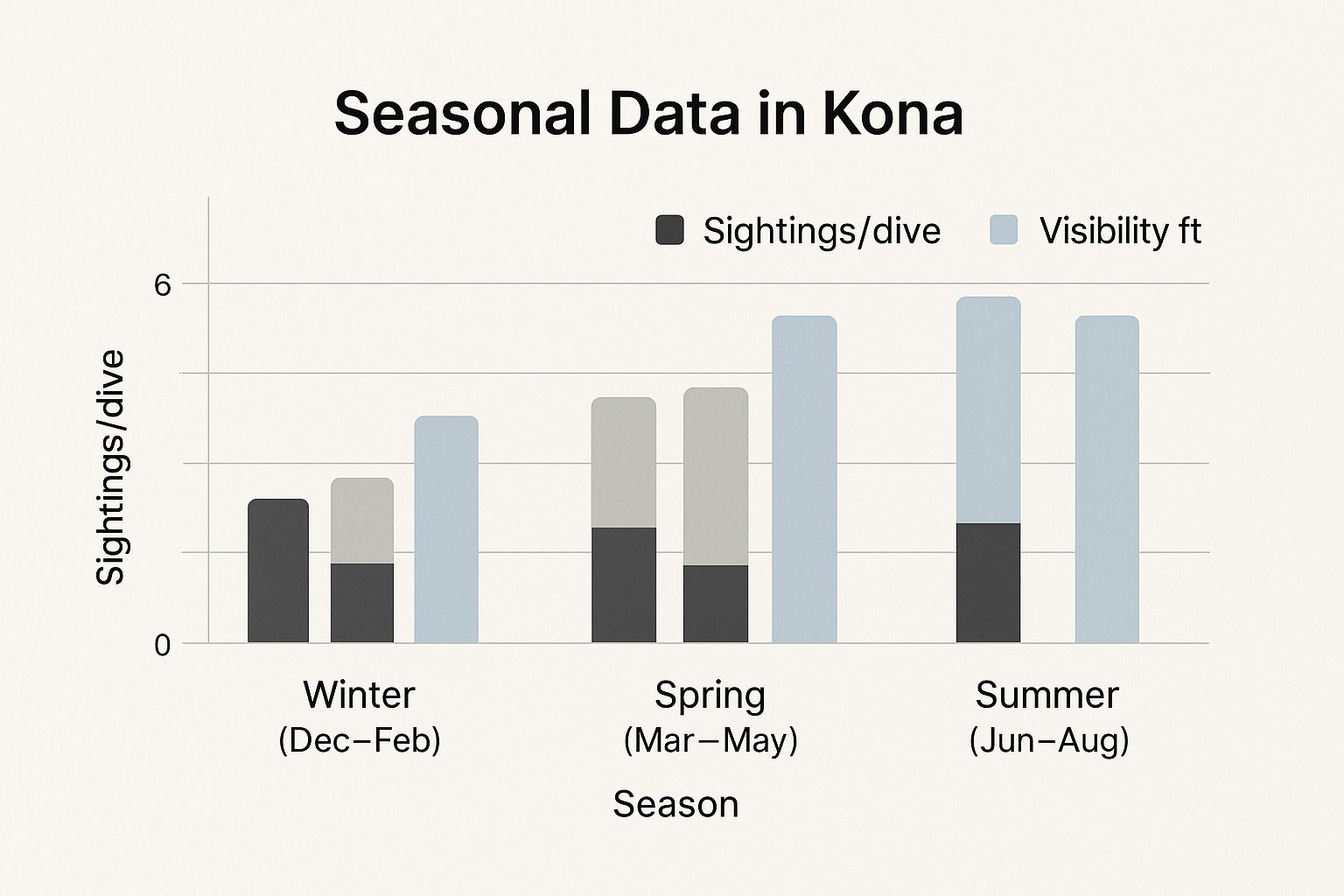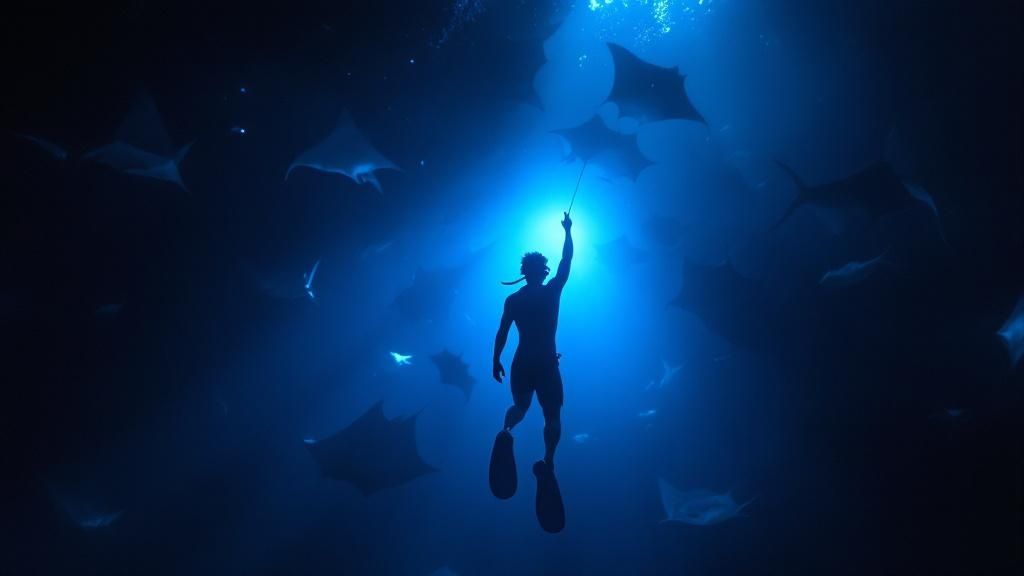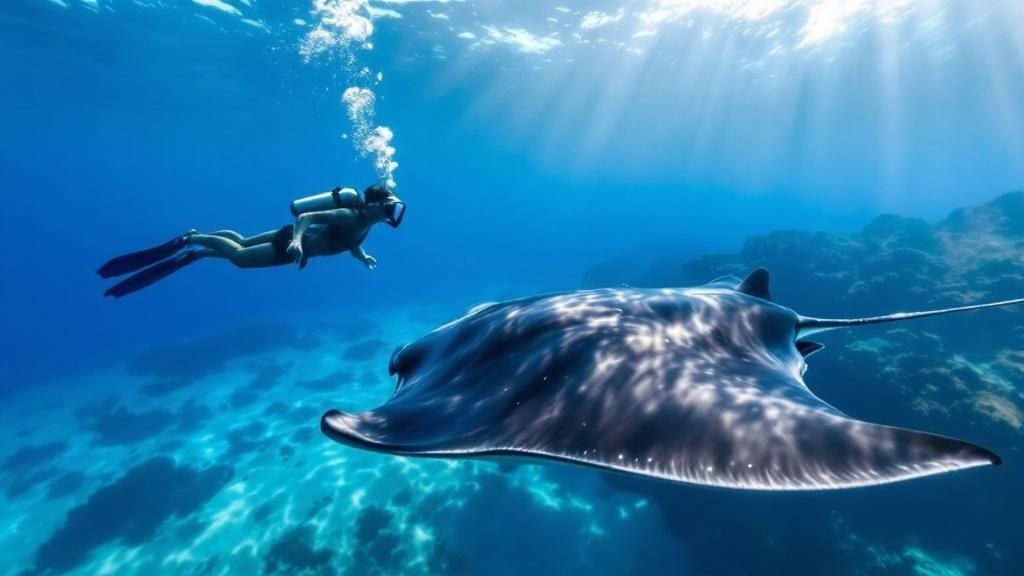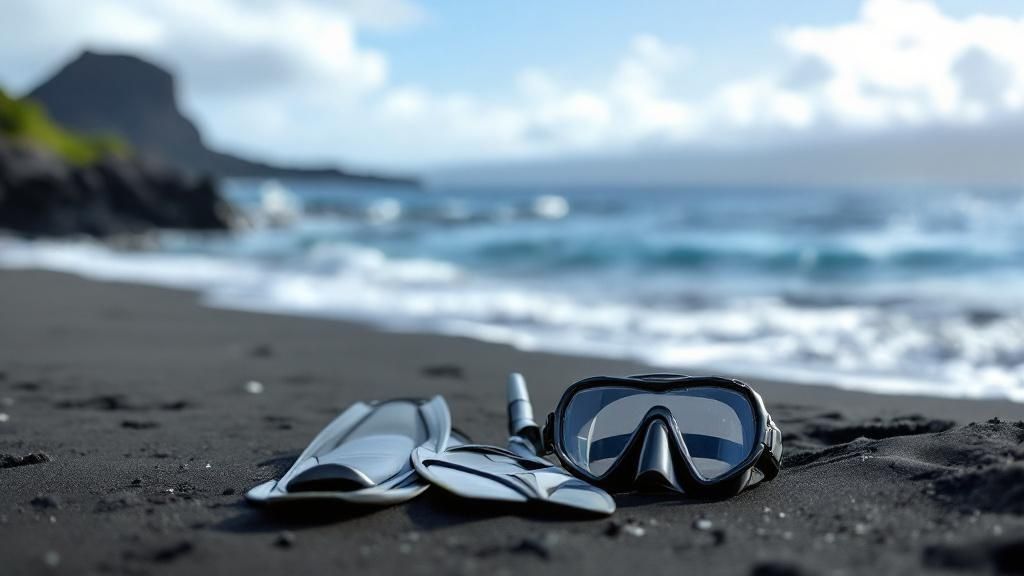Manta Ray Snorkel Kona: Your Complete Hawaii Adventure Guide
- Byron
- Jun 3
- 12 min read
Why Kona Delivers The World's Best Manta Ray Encounters
Kona, Hawaii, isn't just a great spot for manta ray snorkeling; it's arguably the best spot on the planet. This isn't a coincidence. The unique combination of ocean currents, volcanic formations, and a thriving plankton population creates an ideal environment for these gentle giants. Warm currents deliver nutrient-rich waters to the Kona coast, supporting an abundance of microscopic plankton – the manta ray's primary food source. These plankton blooms create a feast, attracting mantas from the surrounding ocean.
This reliable food source, combined with the area's unique underwater topography, explains the frequent manta ray sightings in Kona. Volcanic slopes form natural channels that funnel plankton upwards, making locations like Manta Village and Manta Heaven predictable feeding grounds. This means you're practically guaranteed an encounter, not just a fleeting glimpse.
The Science Behind Kona's Manta Ray Magnetism
The volcanic rock formations play a vital role, too. They provide shelter for the mantas and offer crucial cleaning stations where small fish remove parasites and dead skin. This combination of food and shelter creates a perfect habitat, explaining Kona's large resident manta ray population. Researchers have identified and cataloged over 300 individual mantas in the area, each with unique markings, allowing for ongoing research and conservation.
Furthermore, the strategic use of underwater lighting during night snorkeling tours enhances the natural plankton attraction. These lights, carefully placed by tour operators, mimic the moon's reflection on the water, attracting even more plankton, and therefore, more manta rays. This creates a spectacular display as these graceful creatures, with wingspans reaching up to 12 feet, perform acrobatic feeding maneuvers just below the surface.
Kona's Remarkable Manta Ray Sighting Success Rate
Manta ray snorkeling in Kona is famous for its high success rate. Participants have an impressive 80% to 90% chance of encountering these majestic creatures. This consistent sighting rate attracts roughly 80,000 participants annually, making it one of the most sought-after marine experiences worldwide. Find more detailed statistics here: Manta Ray Snorkel Kona Statistics. This combination of natural factors and thoughtfully managed tour practices makes Kona an exceptional location for manta ray encounters. The near-guaranteed sightings, combined with the beautiful Hawaiian coastline, make a manta ray snorkel in Kona a truly unique experience.
Finding Your Perfect Manta Ray Snorkeling Spot In Kona
Not all manta ray snorkeling sites are created equal. Choosing the right location can significantly impact your experience, from the depth of the water to the number of mantas you're likely to encounter. Kona offers a variety of spots, each with its own unique charm. Understanding these differences will help you select the perfect location for your skill level and what you hope to see.
Kona's Premier Manta Ray Snorkeling Sites
The Kona Coast is home to two main locations for manta ray snorkeling: Manta Village (often near Garden Eel Cove) and Manta Heaven (Keauhou Bay). Manta Village is a particularly popular choice because of its shallow waters, generally between 30 to 40 feet deep. This makes it accessible to snorkelers of all skill levels. Manta Ray Snorkeling Spots in Kona offers more details on both Manta Village and Manta Heaven. Manta Heaven, while a bit deeper, offers excellent visibility, making it a great option for more experienced snorkelers.
Beyond depth, the behavior of the manta rays can also vary between locations. At Manta Village, the shallower water often allows for incredibly close encounters, with mantas performing their feeding dances just below the surface. Manta Heaven, on the other hand, often attracts larger groups of mantas, providing a truly breathtaking spectacle.
To help you decide which location best suits your needs, take a look at the comparison table below. It highlights the key differences between Manta Village and Manta Heaven.
To help you choose the perfect spot, we've compiled a comparison of Kona's top manta ray snorkeling locations. This table details key features, depths, and what each spot is best known for.
Location | Depth Range | Skill Level | Best For | Unique Features |
|---|---|---|---|---|
Manta Village | 30-40 ft | Beginner to Intermediate | Close encounters, calm waters | Shallow depth, easy access |
Manta Heaven | 40-50 ft | Intermediate to Advanced | Large manta gatherings, excellent visibility | Deeper water, potential for larger groups |
As you can see, Manta Village offers a more accessible experience for beginners, while Manta Heaven provides a more immersive experience for seasoned snorkelers.
Matching Your Skill Level to the Right Location
If you're a beginner snorkeler, the calmer, shallower waters of Manta Village might be the perfect starting point. The easy access and predictable conditions create a comfortable environment for your first manta ray encounter. More experienced snorkelers looking for a bit of a challenge, however, might prefer deeper locations with exceptional visibility. These sites offer stunning underwater views and the chance to observe different manta behaviors.
For more information on choosing the right spot, check out Top Spots for Snorkeling with Manta Rays. Factors like water depth, currents, and visibility all play a role in ensuring a safe and rewarding snorkeling experience. Consider these carefully when making your selection.
Seasonal Variations and Optimal Conditions
Understanding Kona's seasonal patterns can greatly enhance your manta ray experience. The infographic below illustrates key seasonal data: average manta sightings per dive, average water temperature (°F), and average underwater visibility (ft) for Winter (Dec–Feb), Spring (Mar–May), and Summer (Jun–Aug).

Summer boasts the highest average number of manta ray sightings and the best visibility, as shown in the infographic. Winter, on the other hand, offers cooler temperatures and potentially fewer crowds. This means that while summer offers ideal viewing conditions, winter might be a better choice for those who prefer a more intimate experience with smaller groups. By considering these seasonal variations, you can tailor your trip to find the perfect time and location for an unforgettable manta ray adventure in Kona.
Timing Your Manta Ray Adventure For Maximum Success
Timing is crucial for an unforgettable manta ray snorkel Kona experience. Understanding Kona's seasonal nuances goes beyond simple weather, impacting your encounter significantly. Factors like water temperature, plankton blooms, and even moon phases influence manta ray behavior and your chances of a truly memorable sighting.
Seasonal Variations: Peak Season Vs. Off-Season
Summer months typically bring calmer, clearer waters, ideal for peak manta ray activity. This also means more snorkelers, drawn by optimal visibility and pleasant weather. Manta Ray Snorkeling Kona Insights explores this further. Winter offers a quieter experience, but rougher seas and potentially reduced visibility can impact sightings. There's a trade-off when selecting your travel dates.
Summer offers the best chance of clear water and abundant manta rays, but also larger crowds. Winter, while potentially choppier, provides a more intimate experience with fewer fellow snorkelers. Knowing these differences lets you prioritize what's important. This leads us to finding the best time for your adventure.
Choosing The Right Time For Your Needs
If calm water and maximum visibility are key, summer is your ideal time for a manta ray snorkel Kona adventure. These conditions create a near-perfect environment for observing these gentle giants. Plankton blooms, fueled by warmer water, attract more manta rays, increasing your chances of multiple sightings.
If you prefer a quieter, less crowded experience, consider spring or fall. These shoulder seasons balance decent visibility with fewer people. Water temperatures remain comfortable for enjoyable snorkeling. Best Time To See Manta Rays In Kona offers more detailed guidance. Ultimately, the best time depends on your personal preferences.
The Influence Of Moon Phases
While less obvious than seasonal changes, moon phases also play a role. The darker nights of a new moon can actually enhance your experience. Less ambient light makes the underwater lights used by tour operators even more alluring to plankton. This attracts higher concentrations of manta rays, creating stunning feeding displays. Planning your trip around the lunar cycle further optimizes your manta ray adventure.

Your Night Snorkeling Adventure: What Really Happens

From the moment you step onto the boat, a manta ray snorkel Kona adventure promises a unique experience. This journey culminates with an unforgettable encounter with these magnificent creatures. Let's explore what you can expect during these magical nighttime excursions. We'll delve into the special setup that makes night snorkeling with mantas possible, highlighting how underwater lights create the perfect feeding opportunity.
The Science of the Nighttime Spectacle
The magic begins with specially designed underwater lights. These aren't just for illuminating the water; they play a vital role in attracting plankton. Plankton, microscopic organisms, form the core of the manta ray diet. The lights, strategically placed, mimic the moon's reflection on the water's surface.
This draws the plankton upwards, creating an irresistible feast for the manta rays. As the plankton gather, the manta rays arrive, often performing incredible acrobatics to capture their prey. They glide effortlessly, their impressive wingspans, sometimes reaching up to 12 feet, creating a breathtaking underwater ballet. For a deeper dive into this experience, check out The Ultimate Guide to Night Manta Ray Snorkeling in Kona. This offers a unique opportunity to observe these gentle giants up close in their natural habitat.
The Typical Tour Flow
Most manta ray night snorkel Kona tours follow a similar format. It all begins with a briefing covering manta ray behavior and essential safety protocols. You'll be fitted with snorkeling gear, including a wetsuit, mask, snorkel, and fins. Preparation is key to a comfortable and safe experience.
Once at the snorkel site, you'll enter the water and hold onto a float board equipped with the underwater lights. The guides will position the group for optimal viewing of the manta ray feeding activity. They also share insights into manta ray behavior and answer any questions. Throughout the snorkel, safety remains paramount. Guides are trained lifeguards and maintain constant vigilance, ensuring everyone's well-being in the dark water.
The Emotional Impact: More Than Just a Snorkel
Witnessing these graceful creatures glide just feet away is deeply moving. Many snorkelers describe feelings of awe and wonder, and a profound connection with the ocean. It's more than just observing manta rays; it's about being present in a moment of natural wonder.
This remarkable experience often becomes a cherished travel memory. The unique combination of marine life, the nighttime setting, and close-up encounters makes for a truly unforgettable adventure.
Mastering Your First Manta Ray Snorkeling Experience
Manta ray snorkeling in Kona is an unforgettable adventure. A little preparation, however, can greatly enhance your experience. Whether you're a confident swimmer or a bit hesitant, understanding what to expect will make a world of difference. From finding the best viewing spots to staying relaxed in the water, we'll prepare you for a truly magical encounter.
Essential Preparation Tips: Physical and Mental Readiness
Before you even enter the water, preparing yourself physically and mentally can significantly improve your experience. Even strong swimmers can benefit from practicing basic snorkeling techniques in a pool. This will increase your comfort and confidence in the open ocean.
Familiarizing yourself with the snorkeling equipment, like the mask and fins, can also alleviate any pre-trip anxieties. Visualizing the experience and focusing on the excitement of seeing manta rays can also help calm any nerves. This mental preparation allows you to fully embrace the magic of the moment.
What to Bring (and What to Leave Behind)
Packing the right gear is key for a comfortable snorkel trip. A 3mm wetsuit is usually fine in the warmer months, while a 5mm wetsuit might be preferable during winter. Water shoes are recommended for protection on the boat and when entering and exiting the water.
Don't forget an underwater camera to document your adventure! If you're bringing your own camera, test it thoroughly beforehand. A towel and dry clothes for after the snorkel are essential. If you're prone to seasickness, consider precautions like seasickness medication or acupressure bands. Consult your doctor for personalized recommendations. Check out our guide on top tips for manta ray snorkeling in Kona for a complete packing list.
Respecting the Gentle Giants: Etiquette and Observation Techniques
Manta rays are gentle giants, and responsible observation ensures both their well-being and a better experience for you. Maintain a safe distance and never touch the manta rays. Their protective mucous layer is vital for their immune system, and touching them can disrupt it.
Avoid sudden movements or splashing, which can disturb the mantas. Move slowly and deliberately, allowing these graceful creatures to swim and feed undisturbed. Listen to your guide. They are trained professionals with extensive knowledge about manta rays and the local environment. They'll provide essential instructions for safe interactions and ensure you have the best possible experience.
Managing Expectations and Making the Most of Your Time
While manta ray sightings in Kona are common, remember these are wild animals in their natural environment. Their behavior is unpredictable. Embrace the element of surprise and appreciate every moment, even if it unfolds differently than you imagined.
Focus on being present. The nighttime setting, the dark water, and the graceful movements of the manta rays create a unique and awe-inspiring experience. Even a brief glimpse of these magnificent creatures is a memory to treasure.
Choosing A Manta Ray Tour Operator That Delivers
With so many tour operators offering manta ray snorkel Kona adventures, picking the perfect one can feel overwhelming. The truth is, your choice can make or break your trip. This section will help you navigate the options and identify the hallmarks of a truly exceptional tour.
Key Factors for Choosing a Tour Operator
Finding an amazing manta ray experience boils down to a few key considerations. Think about these points as you research different tour operators:
Safety Record: A tour operator's commitment to safety should be your top priority. Look for certifications, well-maintained equipment, and clear safety protocols.
Group Size: Smaller groups often translate to more personalized attention from the guides and better opportunities to observe the manta rays up close.
Equipment Quality: Comfortable, high-quality snorkeling gear enhances your overall experience and contributes to a safer, more enjoyable time in the water.
Environmental Practices: Sustainable tourism is key. Seek out operators dedicated to minimizing their environmental footprint and protecting the delicate marine ecosystem.
To help you evaluate potential tour operators, we've compiled a handy checklist. This table summarizes the key criteria, things to look for, questions to ask, and potential red flags.
Manta Ray Tour Operator Evaluation Checklist Key criteria and questions to help you choose the best manta ray snorkel tour operator in Kona
Criteria | What To Look For | Questions To Ask | Red Flags |
|---|---|---|---|
Safety Record | Valid certifications, adherence to safety protocols, well-maintained equipment | What is their safety record? Are their guides certified? | Vague answers, lack of transparency, outdated equipment |
Group Size | Smaller groups for a more personalized experience | What is the average group size on their tours? Do they offer private charters? | Overcrowded boats, limited individual attention |
Equipment Quality | Well-maintained masks, snorkels, fins, and wetsuits | What type of snorkeling equipment do they provide? Is it regularly inspected and cleaned? | Damaged or ill-fitting equipment, lack of proper sanitation |
Environmental Practices | Commitment to sustainable tourism, minimizing environmental impact | What are their environmental policies? How do they contribute to conservation efforts? | Disregard for marine life, excessive waste generation |
This checklist provides a framework for making an informed decision. Remember to weigh these factors against your personal preferences and budget.
Questions To Ask and Red Flags To Watch For
Directly asking potential tour operators specific questions is crucial. Here's what you should ask:
What is their safety record and are their guides certified?
What is the typical group size for their tours?
What kind of snorkeling equipment do they provide?
What are their environmental policies?
Do they offer any guarantees about manta ray sightings?
Be cautious of operators who avoid these questions or give vague responses. Extremely low prices might also be a red flag, potentially indicating compromises on safety or quality. For more tips on finding incredible underwater adventures, check out this helpful guide: How to find top underwater adventures in Hawaii.
Evaluating Tour Styles and Pricing
Tour operators offer diverse experiences, from sunset tours to night snorkeling and private charters. Figure out what kind of adventure you're looking for.
Pricing also varies widely. Remember, a higher price doesn't automatically mean a better experience. Carefully compare what's included – equipment rentals, wetsuits, refreshments, and any extras – to determine the best value.
Why the Right Operator Matters
Choosing the right operator ensures a magical manta ray encounter and supports responsible tourism. By selecting operators who prioritize safety, sustainability, and quality, you contribute to the preservation of this incredible marine ecosystem for future generations. This makes your tour more than just a fun activity; it becomes a meaningful contribution to ocean conservation.
Extending Your Kona Manta Ray Adventure Beyond The Water

Your manta ray night snorkel in Kona is an unforgettable experience, a true highlight of any Hawaiian vacation. But the adventure doesn't have to end there. This incredible encounter is the perfect springboard to a deeper exploration of Kona's vibrant ecosystem and rich culture. Think of it as the starting point to an unforgettable Hawaiian getaway.
Complementary Marine Activities
Kona's waters offer a plethora of activities to complement your manta ray experience. Consider a daytime snorkeling trip to explore vibrant coral reefs teeming with colorful tropical fish. For a different perspective, rent a kayak or stand-up paddleboard and glide along the coastline. You might even be lucky enough to spot dolphins or whales, depending on the season.
Scuba diving opens up a whole new world, allowing you to explore deeper reefs and discover a wider array of marine life. If you prefer a more relaxed approach, a glass-bottom boat tour offers stunning underwater views without even getting wet. With so many options, you can tailor your marine adventures to your interests and skill level.
Land-Based Adventures and Cultural Experiences
Kona's allure extends far beyond the ocean. A short drive from Kona, Volcano National Park offers a dramatic glimpse into Hawaii's volcanic landscapes. Explore this geological wonderland and witness the raw power of nature firsthand.
Immerse yourself in Hawaiian culture with a visit to historical sites. Attend a traditional luau with vibrant music and dance. Learn the graceful art of hula. Or explore local coffee plantations and farmers markets to get a taste of Kona's agricultural heritage. These experiences add a rich layer of cultural understanding to your trip.
Capturing and Preserving Your Memories
The magic of your manta ray encounter deserves to be cherished long after you leave. Invest in a high-quality underwater camera to capture stunning photos and videos of these graceful creatures.
Support local artists by purchasing handcrafted artwork or souvenirs inspired by manta rays. These unique treasures serve as tangible reminders of your experience. Consider contributing to local marine research or conservation organizations, making your visit even more meaningful.
Planning Your Ideal Kona Itinerary
To maximize your time, plan your other activities around your manta ray snorkel schedule. Many tours depart in the late afternoon or early evening, leaving your days free for other adventures. Choose accommodations near the departure point for easy access.
Explore the nearby restaurants offering fresh, local Hawaiian cuisine. Savor the flavors of fresh seafood and other island specialties while immersing yourself in the vibrant atmosphere. Careful planning ensures a seamless and magical Hawaiian adventure, creating memories that will last a lifetime.
Ready for the magic? Book your unforgettable manta ray adventure today with Manta Ray Night Snorkel Kona Hawaii Tours!
Comments